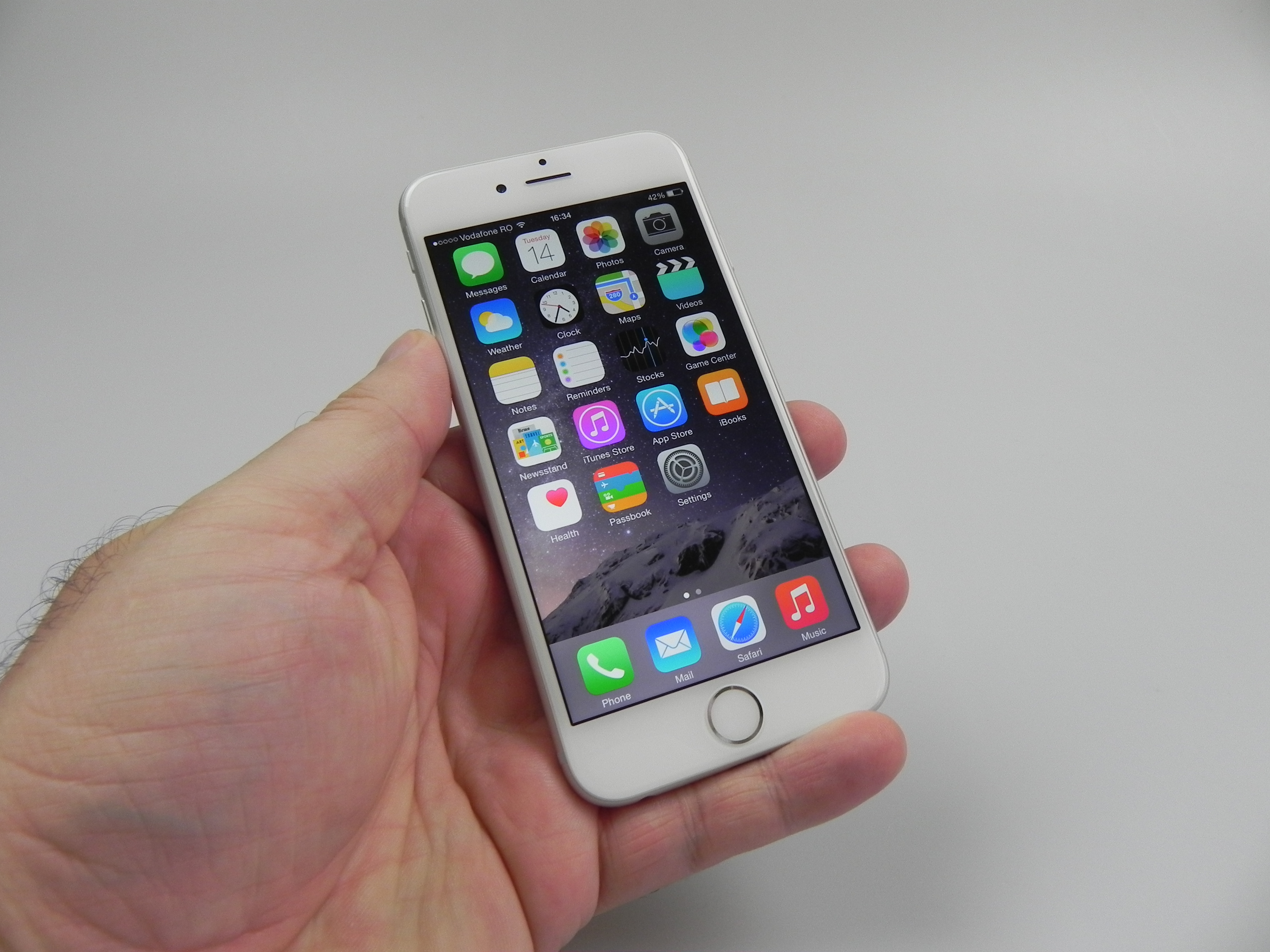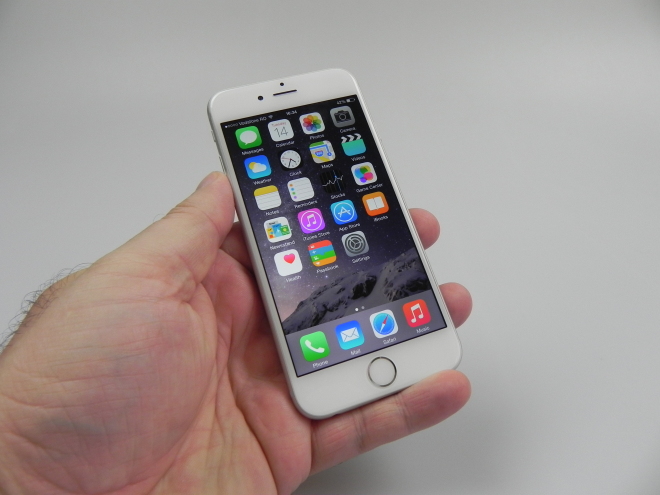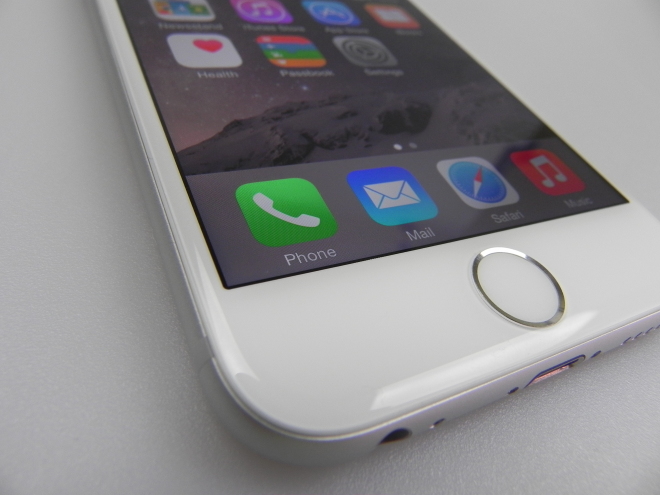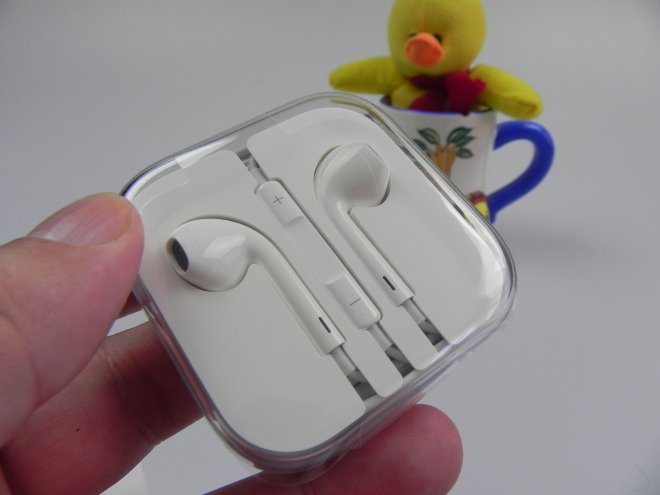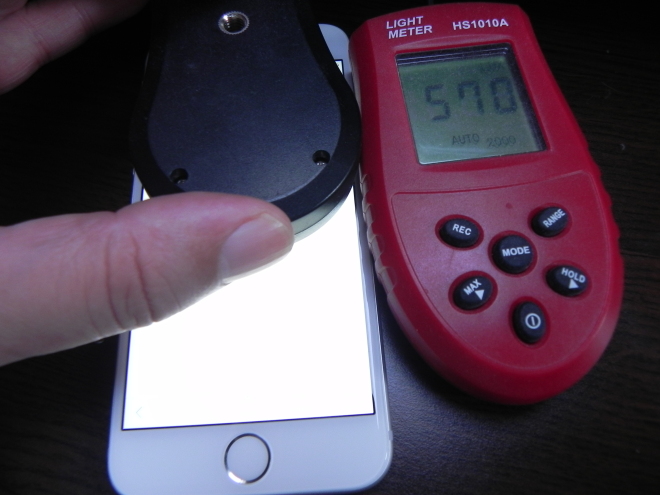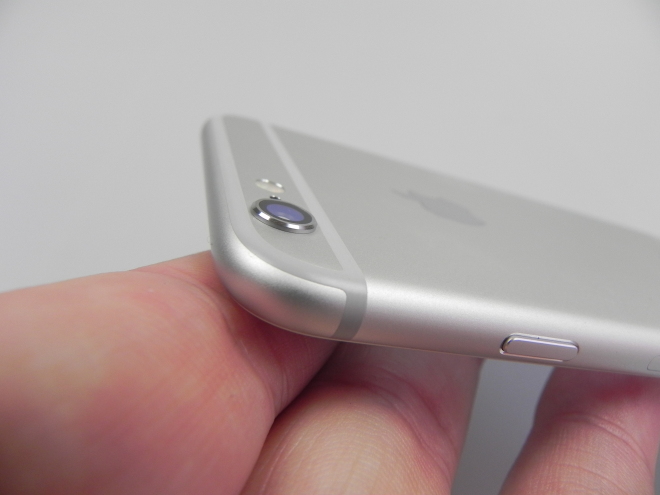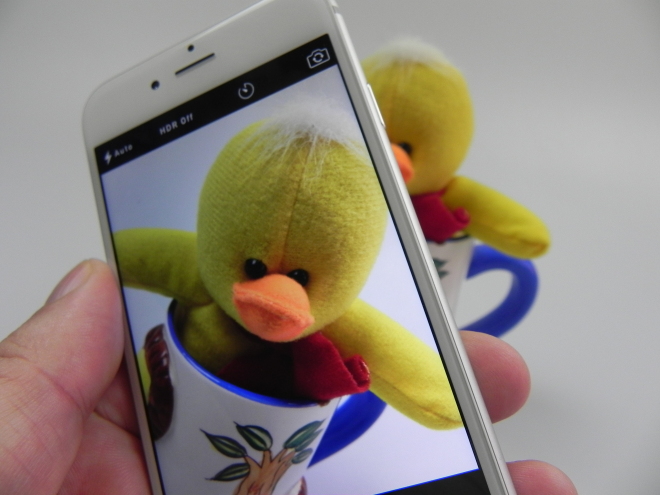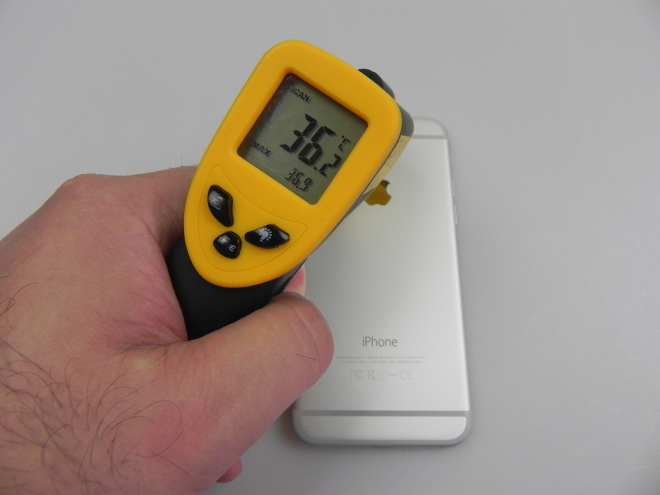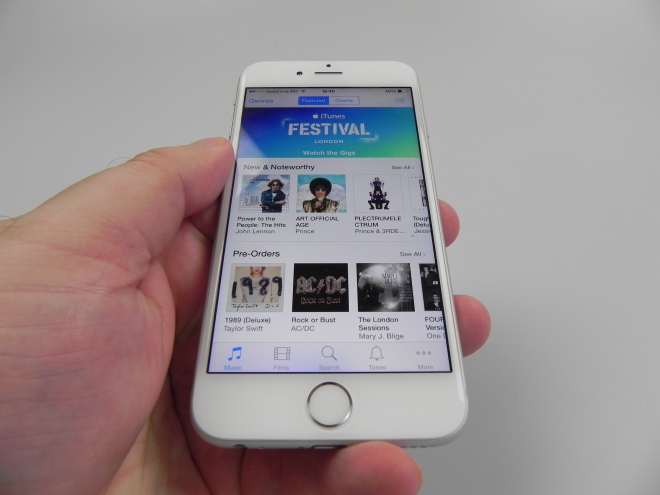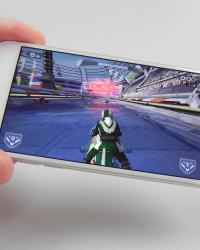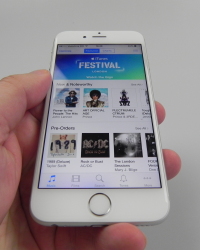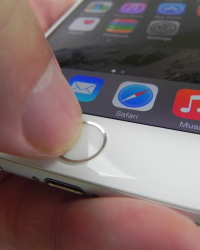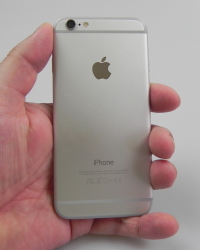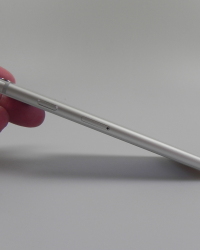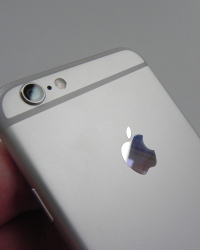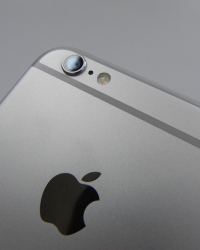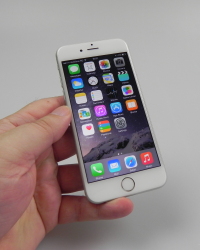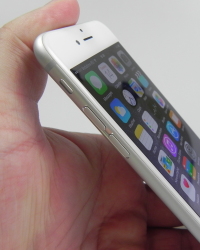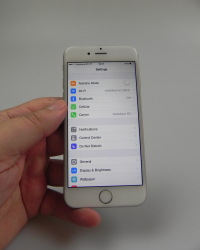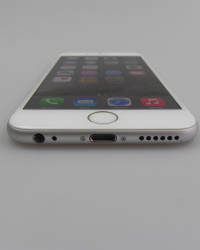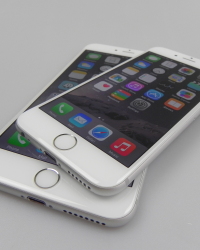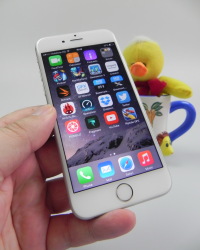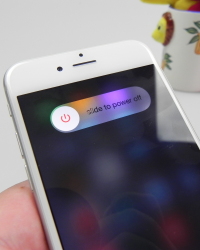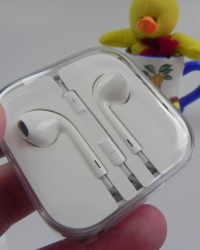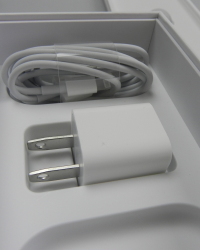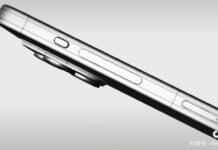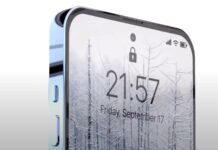After playing with the iPhone 6 Plus via our sister site Tablet News, it’s time to analyze the iPhone 6. Both models were announced in September and the iPhone 6 is the smaller of them, with a 4.7 inch diagonal and a price tag of $199 on 2 year contract in the 16 GB version. It also comes in a $299 64 GB version and $399 128 GB version.
The handset’s design involves a 4.7 inch display and this model is more elegant and compact than the giant iPhone 6 Plus. It has a premium design, with rounded edges and its glass panel goes all the way to the edges. It comes in gold, silver and space gray and measures 6.9 mm in thickness, which is less than the 7.1 mm of the iPhone 6 Plus. The product weighs 129 grams and measures 138.1 mm in length, which is a bit more than the 123.8 mm of the iPhone 5S.
The iPhone 6 is comfy to hold, less slippery than the iPhone 6 Plus, but still a bit slippery. One hand use is easy and the product is not as affected by Bendgate as the bigger model, being more sturdy. The smartphone has an unibody metal design and frankly speaking, I have the plastic stripes it has at the back. Upfront we’ve got scratch proof glass, a front camera, sensors, earpiece and the Home button with Touch ID scanner.
At the back you’ll find a camera, microphone, flash and as you can see, the camera is protruding from the device’s body. On the left there’s mute button and pill shaped volume buttons, while on the right rests the On/Off button that has been moved here from the top. There’s also the nano SIM card slot in the same area. At the bottom there are 6 speaker holes, the Lightning port and audio jack, as well as another microphone.
Overall, this is a premium design, with less compromises than the iPhone 6 Plus. As far as hardware goes, there’s a 4.7 inch display on board, a Retina HD one with LED backlight and IPS LCD panel. We’ve got a 1334 x 750 pixel resolution, a 326 ppi density and an Apple A8 dual core 1.4 GHz processor (64 bit), made by TSMC based on the 20 nm production process. The GPU here is an IMG PowerVR GX6450 and the storage is available in 16, 64 GB and 128 GB versions.
We also get 1 GB of RAM, the M8 motion coprocessor, an 8 megapixel iSight camera at the back, 1.2 MP front camera and Touch ID fingerprint scanner. On the connectivity side there’s WiFi, 802.11 A/B/G/N/AC, Bluetooth 4.0, NFC for Apple Pay, GPS, Glonass, LTE Category 4 (up to 150 Mbps download speed) and other specs include an accelerometer, gyroscope, compass, proximity sensor and barometer. Finally, there’s a Li-Ion 1810 mAh battery inside, that on paper provides 14 hours of 3G talk time, 11 hours of WiFi browsing or 11 hours of video playback.
In our test, that’s done with WiFi on, brightness at 50% and a video playback HD loop we got 11 hours and 30 minutes of playback, which is very good. With average usage, meaning browsing, games, music and all that we got about one day, or one day and a half of regular usage. Meanwhile, the iPhone 6 Plus gets 12 hours of video playback, the iPhone 5s 11 hours and Galaxy S5 also 11 hours, so I’d say we’re doing fine.
The charging takes place in 2 hours and 10 minutes, also being OK. In the Settings area there’s no Power Saving model, but at least you can view the battery usage by app and see which apps use the battery the most. Moving on to the acoustics, we’ve got a 6 hole speaker here, not the 8 hole one from the iPhone 6 Plus and the iPhone 5 had 16 smaller holes by the way. The speaker on the iPhone 6 is surprisingly loud, the sound is clear and we also get good bass. I’d say it beats the iPhone 6 Plus and Galaxy S5 in loudness and clarity. The headphones are the same EarPods we’re used to and even the headphones are better than Samsung’s accessory for example, with splendid bass.
They’re also comfy and the volume is high, but could be higher. In the Settings area, Music section you’ll find options like Shake to Shuffle, Soundcheck and an EQ with settings for various music genres or bass boost, acoustic, flat and more. There’s also a volume limit setting. We also took the decibelmeter to a test of the iPhone 6 and scored 85.2 dBA, beating the iPhone 6 Plus 83.8 dBa, but not the LG G3 and its 87 dBA.
Overall we’ve got very good acoustics and we move on to the display/video area. This is where we find a 4.7 inch Retina HD display, an IPS LCD LED backlit panel with a 1334 x 750 pixel resolution. The iPhone 5s had a resolution of 1136 x 640 pixels, so the upgrade isn’t very impressive here. We do get a good 1400:1 contrast ratio, 326 ppi density and dual domain pixels, for perfect view angles. There’s also a fingerprint resistant coating covering the screen and it behaves well in sunlight.
There’s good contrast and the iPhone 5s had deeper blacks, to be honest. The colors are well calibrated and the resolution is slightly disappointing, this being the sole drawback of the screen. The experience is crisp, clear, bright and we’ve got RGB Stripe pixels in the mix. We used a luxmeter and measured the brightness of the screen, reaching as high as 570 LUX units, on white, which is pretty impressive, although not as impressive as the huge 620+ LUX of the iPhone 6 Plus. At least we beat the 480 LUX of the Galaxy S5…
In the Settings area you can also view the Standard or Zoomed view for the on screen experience. Moving on to the camera, we’re dealing with an 8 MP iSight shooter yet again, this time with 1.5 micron pixels, autofocus with focus pixels and F/2.2 aperture. There’s a True Tone flash in the mix, a 5 element lens and a hybrid IR filter, as well as BSI. We’ve got a sapphire lens cover to protect the protruding camera and there’s no OIS here like on the iPhone 6 Plus, but the electronic stabilization is quite good.
Meanwhile, the front camera gets 81% more light than before, which can be felt. It also does 10 FPS burst and has a F/2.2 aperture. Capture with the back camera is very fast, as is the focus and as far as the UI is concerned, we get the usual minimalistic experience. There’s the front camera shortcut on the left, a timer, HDR, flash options and at the middle of the screen you’ll see a real time exposure slider.
On the right you’ll find 8 filters/effects, the shutter button and gallery shortcut. The capture modes include Photo, Panorama up to 43 MP, Square, Video, Slow Mo (120 or 240 FPS) and Time Lapse. The photos we took during day time with this phone are crisp and clear, but the colors were colder than what we’re used to on an iPhone or any flagship for that matter. The macros of autumn leaves are nice and HDR is very good, discrete and subtle, plus it highlights the contrasts.
However, I can’t exactly feel a huge boost from the iPhone 5s camera, to be honest. The good thing about the iPhone 6 is that you’ll never get a bad shot or missed shot, as it happens to some other models. Focus is good, exposure and white balance are top notch and everything feels sharp. The level of detail is good and quality stays OK even when zooming in. HDR captures two images and stacks them together in a very fast experience.
Panorama is fast and user friendly, with no artifacts and perfect stitching. Once again, the level of noise has dropped only a bit from the iPhone 5s. In the end I must mention that the iPhone 6 is rather a rival for the HTC One M8, not the Galaxy S5 or the Xperia Z2, so it’s in the second tier of flagships in the camera area. As far as low light/night time capture goes, the flash is a bit too strong, we’ve got a yellow hue on top of pics and much noise.
However, the sky at night was captured pretty OK, considering all the facts. If you have a look at the iPhone 6 Plus night time shots, you’ll see that the difference in quality is quite big here. Also, the Xperia Z2 and Lumia 1020 are clearly superior in this area, too. At least the night time shot colors of the iPhone 6 are OK… Moving on to video capture, we’ve got a slow motion video of a jogger to show you, looking fine and Full HD 30 FPS clips are also crisp and clear and offer a good dynamic range, but also under saturation.
Focus is also good and as usual we praised the slow mo more than those generated by rivals. We even tried the image stabilization, the electronic one and we were pretty impressed by it. It’s no iPhone 6 Plus, but it can certainly take the swing of climbing stairs fast. Sadly, the level of noise gets high fast when zooming in during filming. We also compared the 30 FPS and 60 FPS captures by shooting a spinning globe in the same circumstances. Keep in mind that Apple offers here a 4:3 sensor, so it doesn’t have enough horizontal resolution for 4K video capture, in case you were wondering.
The 30 FPS clips have a 17 Mbps bitrate, mono audio and weak audio bitrate, at 60 Kbps. The 60 FPS clips reach a bitrate of 25 Mbps while the 240 FPS slow mo goes to 40 Mbps. The night time video has an OK level of noise, it’s above the Galaxy Note 3 for example, provides OK colors, good focus and it doesn’t have a problem with fuzz around light sources as some other handsets do. Aside from the reflections the low light video capture is good, but still not on par with the iPhone 6 Plus.
Overall, this camera is the equal of the shooter from second tier flagships this year, like the HTC One M8, but it can’t fight in the same league as first tier units, like the Xperia Z2 or Galaxy S5 and certainly not the iPhone 6 Plus. The improvement here is at about 15 to 20% compared to the iPhone 5s. You can also do some photo editing, courtesy of the new options implemented with iOS 8, such as the new crop rotate interface, filters, light, color, b and w options, each of them with many sub options. The gallery now includes a search with criteria like people and places and there’s also a brand new Recently Deleted section.
This model reaches a temperature of 36.9 degrees Celsius, after playing 15 minutes of Riptide GP2, so there’s no overheating here. The web browser, Safari in this case is very fast and instantly loads web pages. We’ve got elegant tabs, private browsing, a section for links shared on social networks, while the keyboard feels comfy and it’s well spaced. We also get the smart QuickType mechanism that anticipates what we’re about to write.
QuickType offers a series of suggestions and learns from you, plus now with iOS 8 Apple offers support for third party keyboards. In the phone section we’ve got WiFi calling, better lit FaceTime, OK signal and exceptional call quality, even better than the one of the iPhone 6 Plus, that frankly speaking was underwhelming. Now let’s check out some benchmarks.
We compared the iPhone 6 with the 6 Plus, iPhone 5s and some of the best Android phones:
Overall the iPhone 6 wins 6 out of 10 battles and only the iPhone 6 Plus beats it in most of them, so Apple is still king of the benchmarks. Obviously, it can run any game and there’s no lag here. As far as the OS goes, it’s iOS 8, with an uglier control center, the Today area widgets and interactible notification banners. There’s also the option to double tap the Home button to trigger the multitasking, now with a section for Favorites and Recents at the top as well.
Spotlight search now integrates Wikipedia, web searches, device searches, email searches and it also looks up apps and podcasts. Siri has Shazam integration, Hey Siri activation (when charging) and Rotten Tomatoes movie features. iCloud Drive comes with data storage and document storage and associates itself with the data stored by some games and apps in the cloud. Family Sharing offers the option for up to 6 people to use the same card.
Then there’s Apple Pay relying on NFC and Touch ID, working fast and being precise. You can now send audio messages via iMessage and there are new gestures in the email app. Handoff will also allow you to continue the work you started on a document on the Mac on the iPad or iPhone. The preinstalled apps list includes Calendar, Weather, Maps, Videos, Notes, Reminders, Stocks, Game Center, Newsstand, iTunes Store, App Store, iBooks and Health, with data like weight, glucose, pulse, BP, BMI and more collected by various devices. Then there’s Passbook and I have to say that the homescreens from iOS 8 need a revamp.
We should be done with constantly crowding the homescreens with apps or folders. There has got to be something to stop this chaos… Just imagine someone with a 128 GB device filled with apps.
And now the verdict!
Here are the Pros regarding the iPhone 6:
more hand friendly than the iPhone 6 Plus
comfy
premium design
good battery
superb acoustics
great screen
good camera, but not on par with the competition
nice slow motion capture
high performance
very good phone calling quality
And the Cons:
slippery
not impressive camera
undersaturated pictures
low screen resolution for 2014
poor night capture
UI is starting to feel cluttered
ugly Control Center
chaos in the picture/gallery area (till Camera Roll came back with iOS 8.1)
We give the iPhone 6 a 9.5 out of 10 for design, a 9.4 for hardware and a 9 for OS and UI. The final grade is 9.3 out of 10 for the iPhone 6 and this model stands out through the battery, acoustics, brightness, high performance hardware and slow motion capture. Is it worth a buy if you have an iPhone 5s? I’d say yes, because the new diagonal really hits the spot, but if that’s not a problem for you, you can hold off a bit longer.

